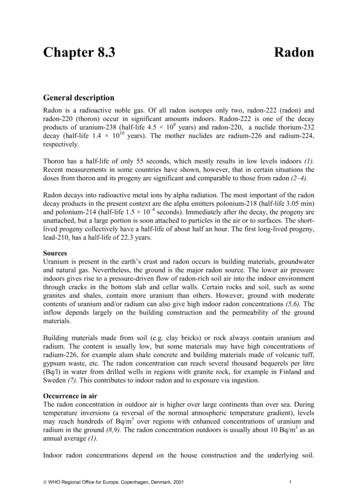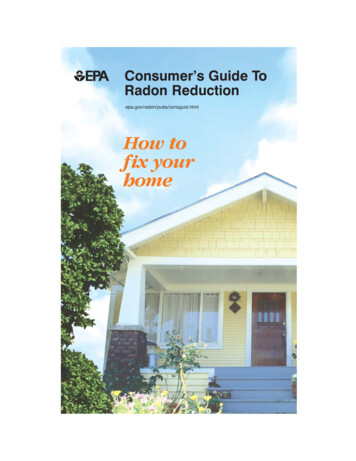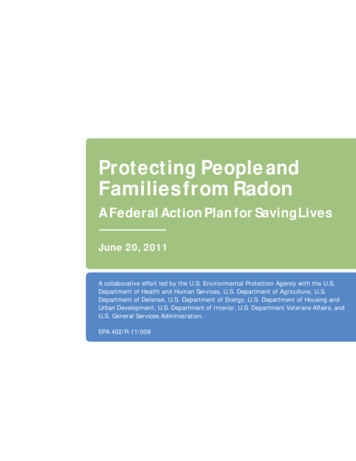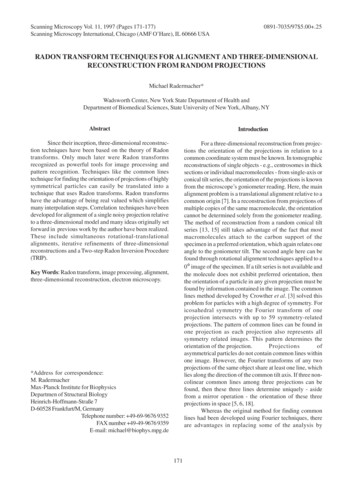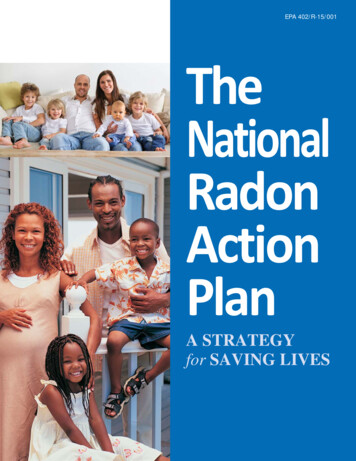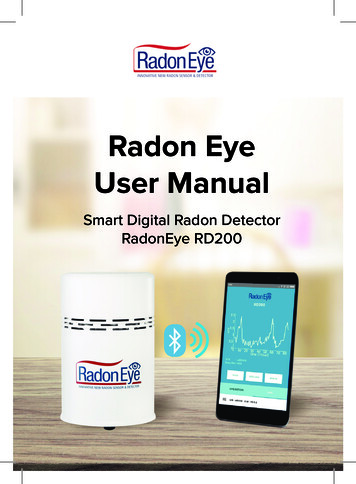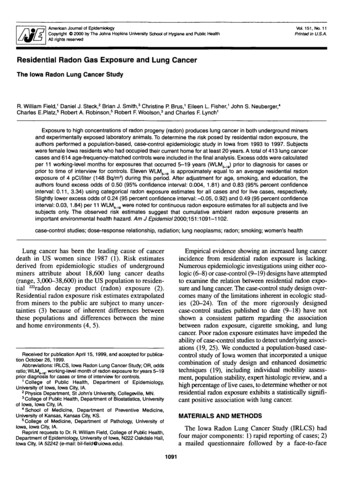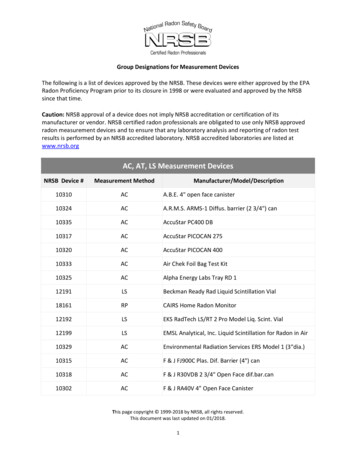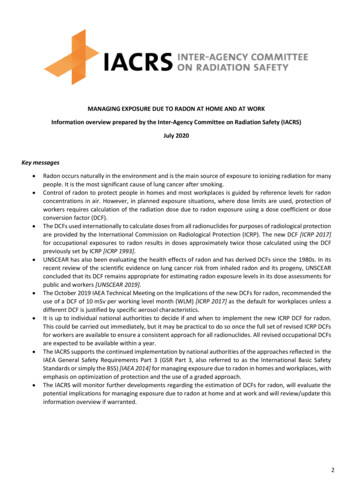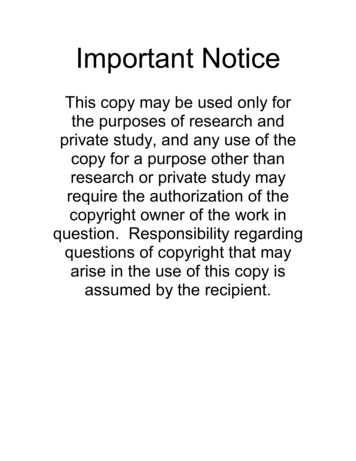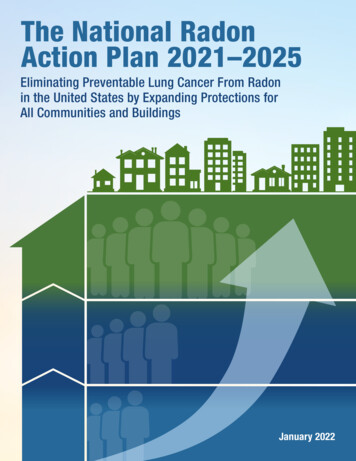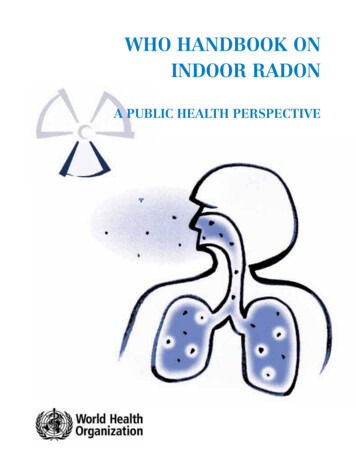
Transcription
WHO HANDBOOK ONINDOOR RADONA PUBLIC HEALTH PERSPECTIVE
WHO HANDBOOK ONINDOOR RADONA PUBLIC HEALTH PERSPECTIVE
WHO Library Cataloguing-in-Publication DataWHO handbook on indoor radon: a public health perspective / edited by Hajo Zeeb, andFerid Shannoun.1.Radon - adverse effects. 2.Air pollutants, Radioactive. 3.Air pollution, Indoor. 4.Carcinogens,Environmental. 5.Radiation, Ionizing. 6.Lung neoplasms. 7.Environmental exposure. I.Zeeb,Hajo. II.Shannoun, Ferid. III.World Health Organization.ISBN 978 92 4 154767 3(NLM classification: WN 615) World Health Organization 2009All rights reserved. Publications of the World Health Organization can be obtained from WHO Press,World Health Organization, 20 Avenue Appia, 1211 Geneva 27, Switzerland (tel.: 41 22 791 3264; fax: 41 22 791 4857; e-mail: bookorders@who.int). Requests for permission to reproduce or translate WHOpublications – whether for sale or for noncommercial distribution – should be addressed to WHO Press,at the above address (fax: 41 22 791 4806; e-mail: permissions@who.int).The designations employed and the presentation of the material in this publication do not imply theexpression of any opinion whatsoever on the part of the World Health Organization concerning the legalstatus of any country, territory, city or area or of its authorities, or concerning the delimitation of itsfrontiers or boundaries. Dotted lines on maps represent approximate border lines for which there maynot yet be full agreement.The mention of specific companies or of certain manufacturers’ products does not imply that theyare endorsed or recommended by the World Health Organization in preference to others of a similarnature that are not mentioned. Errors and omissions excepted, the names of proprietary products aredistinguished by initial capital letters.All reasonable precautions have been taken by the World Health Organization to verify the informationcontained in this publication. However, the published material is being distributed without warranty ofany kind, either expressed or implied. The responsibility for the interpretation and use of the materiallies with the reader. In no event shall the World Health Organization be liable for damages arising fromits use.Printed in FrancePhoto cover: Swiss Federal Office of Public HealthDesign and layout: Patrick Tissot/WHO
ContentsAcknowledgementsContributors / participantsPrefaceExecutive ION11. HEALTH EFFECTS OF RADON1.1 Lung cancer risks in radon-exposed miners1.2 Lung cancer risks in the general population from indoor radon1.3 Radon and diseases other than lung cancer1.4 Burden of lung cancer caused by indoor radon34714142. RADON MEASUREMENTS2.1 Measurement devices2.2 Measurement protocols2.3 Quality assurance for radon measurements212328303. RADON PREVENTION AND MITIGATION3.1 Organization of radon prevention and mitigation actions3.2 Radon prevention strategies in new constructions3.3 Radon mitigation strategies in existing buildings414144494. COST-EFFECTIVENESS OF RADON CONTROL4.1 The framework of cost-effectiveness analysis4.2 Previous economic evaluations of radon prevention and mitigation4.3 Example of a cost-effectiveness analysis575862635. RADON RISK COMMUNICATION5.1 Fundamentals, strategies and channels5.2 Framing radon risk issues for risk communication5.3 Core messages for radon risk communication5.4 Communication campaigns73747578796. NATIONAL RADON PROGRAMMES6.1 Organization of a national radon programme6.2 National radon surveys6.3 National reference levels6.4 Building regulations and building codes6.5 Identification and remediation of homes with high radonconcentrations838486899191iii
Declaration of interests statementAll the individuals who participated in the meetings of the International Radon Projectwere asked to inform WHO if at any time a conflict of interest, whether actual orpotential, could be perceived in their work and they were required to sign a conflict ofinterest statement. There was no conflict of interest for any participants contributedto the preparation of this document.iv
AcknowledgementsThis Handbook was developed by the Department of Public Health and Environmentwithin the framework of the WHO International Radon Project. It is based on thecontribution of more than 100 scientists and radon experts, who participated inseveral consultation meetings to develop this document. Special thanks are given toall the participants and contributors.The Handbook has been organized in six main chapters, each drafted by a respectiveworking group of the WHO International Radon Project. In addition, an editorialgroup was part of the production and reviewing process. WHO is particularly gratefulto this group for their assistance and efforts:Professor William J. AngellDr Francesco BochicchioDr Susan ConrathProfessor Sarah C. DarbyDr David FentonProfessor R. William FieldProfessor Alastair GrayDr Thomas JungDr Michaela KreuzerDr Paul McGaleProfessor James McLaughlinDr Kristy MillerProfessor Terje StrandDr Jan M. ZielinskiWHO also acknowledges the participation of representatives from the InternationalAtomic Energy Agency, the United Nations Scientific Committee on the Effects ofAtomic Radiation, the International Commission on Radiological Protection and theEuropean Commission as observers.WHO thanks Derek Christie, Kelli Donnelly and Florence Samkange-Zeeb for theirvaluable contributions in reviewing and editing the manuscript.WHO gratefully acknowledges the US Environmental Protection Agency (USA),the Department of Health (United Kingdom) and the Department of Environment,Heritage and Local Government (Ireland) for providing the main funding for the WHOInternational Radon Project. It is also indebted to the Federal Office of RadiationProtection (Germany) for its support in organizing meetings in Munich, Bonn andMainz, as well as to the Federal Office of Public Health (Switzerland) for taking overthe printing costs of the handbook.v
Contributors / participantsDr Suminory Akiba1Kagoshima UniversityJapanDr Ian Chell2, 3Department of HealthUnited KingdomProfessor William J. Angell 3C, EUniversity of MinnesotaUSADr Jing Chen1, 2Health CanadaCanadaDr Hannu Arvela2, 3Radiation and Nuclear Safety AuthorityFinlandDr Bernard Collignan3, OScientific and Technical Center for BuildingsFranceDr Anssi Auvinen1Tampere School of Public HealthFinlandDr Susan Conrath6, EU.S. Environmental Protection AgencyUSADr Michael Bailey2, 6Health Protection AgencyUnited KingdomDr Constantin Cosma2University Babes-BolyaiRomaniaDr Juan Miguel Barros Dios1University of Santiago de CompostelaSpainProfessor Sarah C. Darby1C, EUniversity of OxfordUnited KingdomDr Helene Baysson1Institut de Radioprotection et de Sûreté NucléaireFranceDr Gregoire DuboisOJRC - European CommissionItalyDr Thomas Beck2Federal Office for Radiation ProtectionGermanyDr Eckhard Ettenhuber6Federal Office for Radiation ProtectionGermanyDr Francesco Bochicchio1, 2, 5, 6V, EItalian National Institute of HealthItalyDr David Fenton5, 6C, ERadiological Protection Institute of IrelandIrelandDr Kevin Brand1, 4Health CanadaCanadaProfessor R. William Field 1, 2C, 3, 6, EUniversity of IowaUSADr Analia C. Canoba2Autoridad Regulatoria NuclearArgentinaDr Klaus Gehrcke6Federal Office for Radiation ProtectionGermanyDr Olivier CatelinoisInstitut de Radioprotection et de Sûreté NucléaireFranceProfessor Alastair Gray4C, EUniversity of OxfordUnited KingdomDr Douglas B. Chambers1, OSENS Consultans Lim.CanadaDr Bernd GroscheFederal Office for Radiation ProtectionGermanyDr David S. Chase2, 3New Hampshire Department of EnvironmentUSAMartha Gruson2Federal Office of Public HealthSwitzerland1Working group on health effectsC2Working group on measurementsEEditorial groupObserver3viChair of working groupWorking group on prevention and mitigationO4Working group on cost-effectivenessPProject Coordination5Working group on communicationVVice chair of working group6Working group on national programmes*Since October 2006 at University of Mainz
Dr Matti HakamaFinnish Cancer RegistryFinlandDr Daniel Krewski1, 4University of OttawaCanadaDr Manfred HelmingFederal Ministry for the EnvironmentGermanyDr Hans-Henning Landfermann5Federal Ministry for the EnvironmentGermanyDr Dave Hill1University of OxfordUnited KingdomProfessor James P Mc Laughlin5C, 6, EUniversity College DublinIrelandSándor Horváth5Federal Office of Public HealthSwitzerlandDr Marielle Lecomte2, 3Department of Radiation ProtectionLuxembourgDr Philip JalbertU.S. Environmental Protection AgencyUSADr Vladimir LezhninInstitute of Industrial EcologyRussian FederationDr Jerzy Jankowski2, 3Nofer Institute of Occupational MedicinePolandDr Ilona Mäkeläinen4Radiation and Nuclear Safety AuthorityFinlandDr Philip H. Jenkins2V, 3Bowser-Morner, Inc.USADr Ches Mason6, OInternational Atomic Energy AgencyAustriaDr Barnes JohnsonU.S. Environmental Protection AgencyUSADr Paul McGale1University of OxfordUnited KingdomDr Thomas JungEFederal Office for Radiation ProtectionGermanyDr Susanne Menzler1University of HannoverGermanyDr Gerald KendallHealth Protection AgencyUnited KingdomDr Winfried Meyer3Federal Office for Radiation ProtectionGermanyProfessor Antoine KiesUniversity of LuxembourgLuxembourgDr Jon Miles3, 6Health Protection AgencyUnited KingdomDr Yoon-Shin KimHanyang UniversityRepublic of KoreaDr Kristy Miller5, EU.S. Environmental Protection AgencyUSADr Gerald KirchnerFederal Office for Radiation ProtectionGermanyDr Lars Mjones6Swedish Radiation Protection AuthoritySwedenDr Virginia Koukouliou5Greek Atomic Energy CommissionGreeceDr Christophe Murith6Federal Office of Public HealthSwitzerlandDr Tibor Kovacs3University of PannoniaHungaryDr Alison Offer1University of OxfordUnited KingdomProfessor Lothar Kreienbrock1University of HannoverGermanyProfessor Herwig Paretzke1Helmholtz Zentrum MünchenGermanyDr Michaela Kreuzer1, EFederal Office for Radiation ProtectionGermanyDr Laima Pilkyte2Radiation Protection CentreLithuaniaDr Maria Pavia1University of CatanzaroItalyDr Georges Piller6Federal Office of Public HealthSwitzerlandvii
Dr André Poffin5Federal Agency for Nuclear ControlBelgiumDr Shinji Tokonami2, 3National Institute of Radiological SciencesJapanDr Dobromir Pressyanov2, 3University of SofiaBulgariaDr Ladislav Tomasek1, 4National Radiation Protection InstituteCzech RepublicDr Lidia Purghel2National Inst. for Physics and Nuclear EngineeringRomaniaDr Jochen Tschiersch2VHelmholtz Zentrum MünchenGermanyDr Luis Santiago Quindós Poncela2, 3, 5University of CantabriaSpainDr Lene Veiga1Radiation Protection and Dosimetry InstituteBrazilDr Alberto Ruano Ravina1University of Santiago de CompostelaSpainDr Hilary Walker5Health Protection AgencyUnited KingdomDr Simon Read1University of OxfordUnited KingdomDr Zuoyuan WangNational Institute of Radiation ProtectionChinaDr Wolfgang Ringer2, 3, 6Austrian Agency for Health and Food SafetyAustriaDr Wolfgang WeissOFederal Office for Radiation ProtectionGermanyGeorges-André Roserens3Federal Office of Public HealthSwitzerlandProfessor H.-Erich Wichmann1Helmholtz Zentrum MünchenGermanyChris Scivyer 2Building Research EstablishmentUnited KingdomDr Peter WiedemannResearch Center JuelichGermanyProfessor Bing Shang1, 2, 3National Institute for Radiological ProtectionChinaDr Yuji Yamada2National Institute of Radiological SciencesJapanDr Margaret Smith1University of OxfordUnited KingdomDr Hidenori Yonehara4, 6National Institute of Radiological SciencesJapanDr Ann-Louis Söderman5, 6Swedish Radiation Protection AuthoritySwedenDr Mikhail Zhukovsky1, 2Institute of Industrial EcologyRussian FederationProfessor Daniel Steck2VSt. John’s UniversityUSADr Jan M. Zielinski1V, EHealth CanadaCanadaProfessor Terje Strand2, 3, 4V, 5, ENorwegian Radiation Protection AuthorityNorwayDr Zora S. Zunic5Institute of Nuclear SciencesSerbiaDr Quanfu Sun4, 5National Institute for Radiological ProtectionChinaDr Pavel Szerbin5Institute for Radiobiology and RadiohygieneHungaryDr Josef ThomasNational Radiation Protection InstituteCzech RepublicDr Margot Tirmarche1, OInstitut de Radioprotection et de Sûreté NucléaireFranceviiiWorld Health OrganizationDr Zhanat Carr5, PDr Emilie van DeventerDr Annette Prüss-ÜstünDr Michael RepacholiDr Ferid ShannounP, EDr Hajo Zeeb1, 6, P, E, *
PrefaceRadon is the second cause of lung cancer in the general population, after smoking.Epidemiological studies have provided convincing evidence of an association betweenindoor radon exposure and lung cancer, even at the relatively low radon levelscommonly found in residential buildings. However, efforts to act on this informationand to reduce the number of lung cancers related to radon exposures have so faronly been successful in very few countries.The World Health Organization first drew attention to the health effects fromresidential radon exposures in 1979, through a European working group on indoorair quality. Further, radon was classified as a human carcinogen in 1988 by IARC, theWHO specialized cancer research agency. In 1993, a WHO international workshopon indoor radon, organized in Eilat, and involving scientists and radon expertsfrom Europe, North America and Asia, was a first step towards a unified approachto controlling radon exposures and advising on the communication of associatedhealth risks.In 2005, WHO established the International Radon Project to identify effectivestrategies for reducing the health impact of radon and to raise public and politicalawareness about the consequences of long term exposure to radon. Participantsand contributors from more than 30 countries worked together towards a globalunderstanding of a wide range of issues associated with indoor radon.A key product of the WHO International Radon Project is this handbook, whichfocuses on residential radon exposure, emphasizing its impact from a public healthpoint of view. It includes detailed recommendations on radon health risk reductionand sound policy options for prevention and mitigation of radon. The handbook isintended for countries that plan to develop national programmes or extend theiractivities regarding radon, as well as for stakeholders involved in radon control suchas the construction industry and building professionals.WHO recommends that, where indicated, comprehensive radon programmes bedeveloped, preferably in close linkage with indoor air quality and tobacco controlprogrammes. This handbook reflects the long-standing experience of severalcountries with such radon programmes. WHO looks forward to continuing andenhancing the collaboration with countries to achieve the challenging goal ofreducing the radon-associated health burden.Dr Maria Neira, DirectorDepartment of Public Health and EnvironmentWHO, Genevaix
Executive summaryRadon is a radioactive gas that emanates from rocks and soils and tends toconcentrate in enclosed spaces like underground mines or houses. Soil gas infiltrationis recognized as the most important source of residential radon. Other sources,including building materials and water extracted from wells, are of less importancein most circumstances. Radon is a major contributor to the ionizing radiation dosereceived by the general population.Recent studies on indoor radon and lung cancer in Europe, North America andAsia provide strong evidence that radon causes a substantial number of lungcancers in the general population. Current estimates of the proportion of lungcancers attributable to radon range from 3 to 14%, depending on the averageradon concentration in the country concerned and the calculation methods.The analyses indicate that the lung cancer risk increases proportionally withincreasing radon exposure. As many people are exposed to low and moderateradon concentrations, the majority of lung cancers related to radon are caused bythese exposure levels rather than by higher concentrations. Radon is the secondcause of lung cancer after smoking. Most of the radon-induced lung cancer casesoccur among smokers due to a strong combined effect of smoking and radon.Radon measurements are relatively simple to perform and are essential to assessradon concentration in homes. They need to be based on standardized protocols toensure accurate and consistent measurements. Indoor radon concentration varieswith the construction of buildings and ventilation habits. These concentrations notonly vary substantially with the season but also from day to day and even from hourto hour. Because of these fluctuations, estimating the annual average concentrationof radon in indoor air requires reliable measurements of mean radon concentrationsfor at least three months and preferably longer. Short-term measurements provideonly a crude indication of the actual radon concentration. Quality assurance forradon measurement devices is highly recommended in order to ensure the qualityof measurements.Addressing radon is important both in construction of new buildings (prevention)and in existing buildings (mitigation or remediation). The primary radon preventionand mitigation strategies focus on sealing radon entry routes and on reversing theair pressure differences between the indoor occupied space and the outdoor soilthrough different soil depressurization techniques. In many cases, a combination ofstrategies provides the highest reduction of radon concentrations.The choice of radon prevention and mitigation interventions can be based on ananalysis of cost-effectiveness. In this approach, net health-care costs are set inrelation to net health benefits for a variety of actions or policies, providing an indexwith which these actions can be prioritized.x
Selected analyses indicate that preventive measures in all new buildings are costeffective in areas where more than 5% of current dwellings have radon concentrationsabove 200 Bq/m3. Prevention in new homes tends to be more cost-effective thanmitigation of existing homes. In some low-risk areas the measurement costs may behigher than the mitigation costs (for existing dwellings) due to the high number ofhomes that will have to be tested compared to the proportion of homes mitigated.Even if analyses indicate that remediation programmes are not cost-effective on anationwide basis, indoor radon at high concentrations poses a considerable risk oflung cancer for individuals and requires mitigation.Since the general public is often unaware of the risks associated with indoor radon,special risk communication is recommended. Radon risk communication needs tobe focused on informing the different audiences and recommending appropriateaction on reducing indoor radon. A cooperative effort is required, involving technicaland communication experts, to develop a set of core messages. Radon risk messagesshould be kept as simple as possible and quantitative risk information must beexpressed to the public in clearly understandable terms. It is useful, for example, toplace the risk of lung cancer due to radon in comparison with other cancer risks, orwith common risks in everyday life.Public health programmes to reduce the radon risk should be ideally developed onnational level. Such national radon programmes would be designed to reduce theoverall population’s risk from the national average radon concentration as well asthe individual risk for people living with high radon concentrations.A national radon policy should focus on identifying geographical areas wherepopulations are most at risk from radon exposures and raising public awarenessabout the associated health risk. Key elements for a successful national programmeinclude collaboration with other health promotion programmes (e.g. indoor airquality, tobacco control) and training of building professionals and other stakeholdersinvolved in the implementation of radon prevention and mitigation. Appropriatebuilding codes that require the installation of radon prevention measures inhomes under construction should be enacted, and the measurement of radonduring the purchase and sale of homes is useful to identify those with high radonconcentrations.A national reference level for radon represents the maximum accepted radonconcentration in a residential dwelling and is an important component of a nationalprogramme. For homes with radon concentrations above these levels remedialactions may be recommended or required. When setting a reference level, variousnational factors such as the distribution of radon, the number of existing homeswith high radon concentrations, the arithmetic mean indoor radon level and theprevalence of smoking should be taken into consideration. In view of the latestscientific data, WHO proposes a reference level of 100 Bq/m3 to minimize healthhazards due to indoor radon exposure. However, if this level cannot be reachedunder the prevailing country-specific conditions, the chosen reference level shouldnot exceed 300 Bq/m3 which represents approximately 10 mSv per year according torecent calculations by the International Commission on Radiation Protection.The overall goal of this handbook is to provide a current overview of the majoraspects of radon and health. It does not aim to replace existing radiation protectionstandards, rather it puts emphasis on issues being relevant for the comprehensiveplanning, implementation and evaluation of national radon programmes.xi
LWLMActivated charcoal detectorActive soil depressurizationAmerican Society for Testing and MaterialsAlpha track detectorBiological Effects of Ionizing RadiationCost benefit analysisContinuous radon monitorDisability adjusted life yearDepartment for Environment, Food and Rural AffairsDeutsches Institut für NormungDouble alpha-track detector methodEuropean CommissionElectret ion chamberElectronic integrating deviceExcess relative riskEnvironmental tobacco smokeGeometric meanGeometric standard deviationHeating ventilation and air conditioningInternational Agency for Research on CancerInternational Commission on Radiological ProtectionLiquid scintillation countingMinimum detectable concentrationNational Council on Radiation Protection and MeasurementsNational Research CouncilOrganization for Economic Co-operation and DevelopmentPotential alpha energy concentrationPassive soil depressurizationProficiency testQuality assuranceQuality adjusted life yearQuality controlRelative percent differenceRelative riskSystems for Test Atmospheres with RadonUnited Nations Scientific Committee on the Effects of Atomic RadiationUnited States Department of Health and Human ServicesUnited States Environmental Protection AgencyWorld Health OrganizationWorking levelWorking level month
GlossaryBuilding professionals: this term describes all those involved in the design,construction, renovation and maintenance of buildings as well as those involved inthe design and installation of radon prevention and mitigation systems.Concentration: the activity of radon gas in terms of decays per time in a volume of air.The unit of radioactivity concentration is given in Becquerel per cubic metre (Bq/m3).Disability adjusted life year (DALY): a measure of health based on the length of aperson’s life adjusted by their level of disability. DALYs lost are commonly calculatedwith reference to a “gold standard” of full health in a country with long life expectancy:for example, a person in Southern Africa disabled by blindness who then dies aged45 has lost several years of full health as a result of blindness, but also 35 years oflife compared to the average life expectancy of 80 in Japan.Equilibrium factor (F-factor): radon is constantly decaying and giving riseto radon progeny. These are short-lived and decay until reaching a long-livedisotope of lead. The F-factor is used to describe the ratio between radon and itsprogeny. An F-factor of 1 means equal amounts of radon and its progeny. AnF-factor of 0.4 is taken as representative for homes.Excess relative risk (ERR): the ERR is an epidemiological risk measure thatquantifies how much the level of risk among persons with a given level of exposureexceeds the risk of non-exposed persons.Exposure: the amount of time a person spends in any given radon concentration. Itis determined by multiplying the radon concentration, measured in Bq/m3 of eacharea by the amount of time spent in that area.Geometric mean (GM): the GM represents the central tendency or typical value ofa set of numbers which follow a log-normal distribution. The GM is calculated byfinding the n-th root of the product of n numbers.Homes or dwellings: these terms are interchangeable and refer to all detached andattached structures used for non-occupational human residency. The term “house”refers to a detached single-family dwelling.Householders: this is a term of convenience used to collectively describe those livingin a home or dwelling. It refers to occupants of the home, including owners of theproperty as well as tenants.Long-term measurement: a measurement of radon concentrations that takes placeover period of 3 months up to 1 year.Membranes or barriers: both terms refer to a continuous plastic type sheet that isplaced across the foundation of the house during construction, whose purpose is toprevent radon entering the house when construction is completed.xiii
Mitigation or remediation: these terms are interchangeable and refer to steps takenin an existing building to reduce radon entry.National radon programme: a series of measures, aimed at minimizing exposure ofthe population to radon, that are implemented by agencies designated by a nationalauthority.National radon survey: a survey carried out to determine the radon concentrationdistribution, which is representative of the radon exposure to the population withina country.Prevention: in the context of this hanbook, measures installed during constructionof new homes or dwellings aimed at preventing the entry of radon.Quality adjusted life year (QALY): a year of life adjusted for its quality, valueor utility. One year in full health is given the value of 1 QALY; the same period inmoderate pain, for example, might be given a value of 0.7 QALY. The QALY aims toincorporate quality of life and quantity of life in one measure, and so is attractive tohealth economists as a general measure of health outcome.Quality assurance: the set of planned and systematic actions put in place at specifiedstages of the radon measurement process to ensure confidence and accuracy of themeasurement results.Quality control: the quality checks carried out within the radon measurementlaboratory as part of the overall quality assurance system.Radon-prone area: an area where a significant proportion of homes exceed thereference level.Reference level: this level does not define a rigid boundary between safety anddanger but represents the annual mean radon concentration in a home above whichit is strongly recommended or required to reduce the radon concentration.Relative Risk (RR): the RR is a ratio of the probability of a disease occurring in theexposed group versus a non-exposed group.Renovation: work that changes the structure, heating, cooling and or mechanicalsystems of the home that may open up new entry routes for radon, disrupt ventilationpatterns or change air pressure patterns.Short-term measurement: a measurement of radon concentrations that takes placeover a period of not more than 3 months.Social marketing: the application of marketing along with other ideas and techniquesto achieve specific behavioral goals for a social good. It is applied in health promotioncampaigns to change people’s behavior, for example in anti-smoking messages orin efforts aimed at preventing skin cancer by encouraging people to avoid excessiveexposure to sunlight.Working level month (WLM): working levels are defined as any combination of theshort-lived progeny in one litre of air that results in the ultimate release of 1.3 x 105MeV of potential alpha particle energy. The cumulative exposure to an individualexposed at this concentration over a “working month” of 170 hours (or at twice thisconcentration over half as long, etc.) is defined as a “working level month” (WLM).xiv
IntroductionThe risks to human health posed by ionizing radiation are well known. Radon gasis by far the most important source of ionizing radiation among those that are ofnatural origin. Radon (222Rn) is a noble gas formed from radium (226Ra), which isa decay product of Uranium (238U). Uranium and radium occur naturally in soilsand rocks. Other decay products of uranium include the isotopes thoron (220Rn)and actinon (219Rn). Radon gas, which has a half-life of 3.8 days, emanates fromrocks and soils and tends to concentrate in enclosed spaces like underground minesor houses. It is a major contributor to the ionizing radiation dose received by thegeneral population.When radon gas is inhaled, densely ionizing alpha particles emitted by depositedshort-lived decay products of radon (218Po and 214Po) can interact with biologicaltissue in the lungs leading to DNA damage. Cancer is generally thought to requirethe occurrence of at least one mutation, and proliferation of intermediate cells thathave sustained some degree of DNA damage can greatly increase the pool of cellsavailable for the development of cancer. Since even a single alpha particle can causemajor genetic damage to a cell, it is possible that radon-related DNA damage canoccur at any level of exposure. Therefore, it is unlikely that there is a thresholdconcentration below which radon does not have the potential to cause lung cancer.Health effects of radon, most notably lung cancer, have been investigated for severaldecades. Initially, investigations focused on underground miners exposed to highconcentrations of radon in their occupational environment. However, in the early 1980s,several surveys of radon con
World Health Organization 2009 All rights reserved. Publications of the World Health Organization can be obtained from WHO Press, World Health Organization, 20 .
